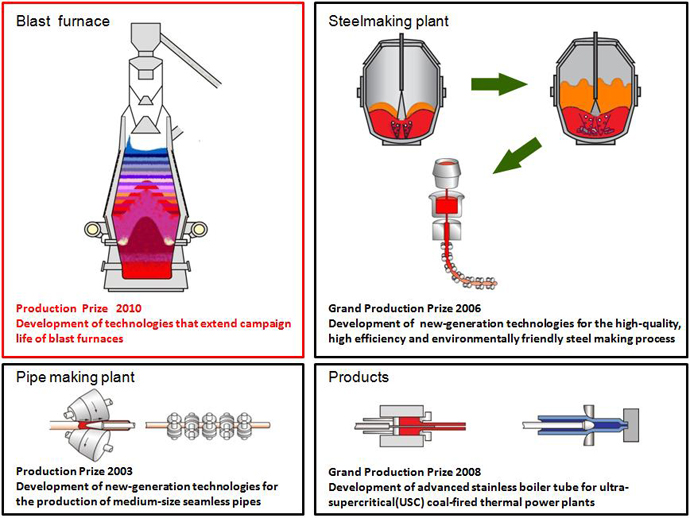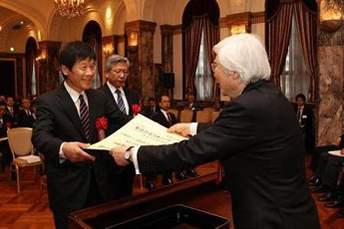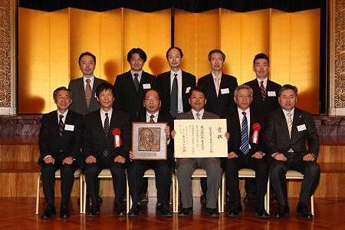Sumitomo Metals Receives 57th Okochi Memorial Foundation Production Prize for “Development of Technologies that Extend Campaign Life of Blast Furnaces”
2011.03.04
- Sumitomo Metal Industries, Ltd.
Today, Sumitomo Metal Industries, Ltd. (Sumitomo Metals) received the 57th Okochi Memorial Foundation Production Prize for its “development of technologies that extend the campaign life of blast furnaces.”
The inner conditions of a blast furnace used to be a “black box” but Sumitomo Metals has developed simulation technologies which enable inner conditions to be quantitatively evaluated. Thanks to operational and repair technologies based on such evaluation, the Wakayama Steel Works' No. 4 blast furnace was commended for achieving the world's longest continuous operation of 10,001 days (27 years and 4 months).
The award on this occasion has resulted in Sumitomo Metals receiving the Okochi Memorial Foundation Prize for all the processes (i.e. blast furnace, steelmaking, manufacturing mill, and products) that are related to manufacturing of seamless pipes, our major products.
1. Development Background
A blast furnace is such a critical facility that it can be called the symbol of steelworks. A blast furnace is relined to resume the operation after its service life has been reached. The relining requires a long repair period (two to four months) and high costs (approximately 30 billion yen.) Therefore, extending the campaign life of a blast furnace is an important issue.
Back in 1982 when the Wakayama Steel Works’ No. 4 blast furnace was blown in, the initial plan was to operate it for seven years, given the expected general service life of five to ten years for a blast furnace back in those days.
2. Features of Developed Technologies
From the early 1970s, Sumitomo Metals worked on finding out the inner activities of a blast furnace, which was then called a “black box.” Since 1991, Sumitomo Metals has developed a variety of new technologies to extend the service life of the No. 4 blast furnace to 20 years or more.
| (1) Developing blast furnace simulation technologies | |
A blast furnace is a huge reactor of about 100 meters in height. In a blast furnace, iron ore and coke are supplied through the top of the furnace and move downward, while hot air at a temperature of about 1,200 ºC is blown in from the side of the bottom of the furnace and moves upward. Throughout the furnace, chemical reactions such as combustion and reduction and physical phenomena such as heat conduction, fusion, and flow take place, interact in a complex manner, and become balanced. Finally, molten pig iron flows out from the bottom of the furnace. With the aim of clarifying those factors in a quantitative manner, Sumitomo Metals became the first in the world to develop a simulation model that indicates actual operations precisely by combining mathematical logic with the constantly-changing factors in a three-dimensional manner. Those factors include the temperature of the furnace, reactions and movements of materials, and the flow of molten pig iron and gas. |
|
| (2) Developing technologies to replace staves | |
The body of a blast furnace consists of three layers. From the outer wall, they are the steel shell, staves (cooling devices made of ferrous castings,) and heat-resistant bricks. Previously when staves became damaged, we were unable to repair them without blowing out the furnace to be relined. However, technologies to replace staves at the time of periodical maintenance work have separated the operating life of staves from the operating life of a blast furnace. |
|
| (3) Developing technologies to inhibit erosion of bricks at the bottom of a blast furnace | |
Bricks at the bottom of a furnace are eroded by high-temperature (about 1,500ºC) molten pig iron and slag during the operation, and cannot be replaced unless the furnace is blown-out and relined. We have developed new technologies to extend the operating life of heat-resistant bricks at the bottom of a furnace by controlling the flow of molten pig iron and slag inside the blast furnace through the adjustment of the molten pig iron's liquidity and the raw materials' weight balance within the furnace. |
3. Results
In July 2009, the Wakayama Steel Works' No. 4 blast furnace achieved the world’s longest continuous operation and contributed to a reduction in relining costs. Wakayama’s No. 5 blast furnace currently has the longest operating life among active blast furnaces in Japan. The technologies that Sumitomo Metals developed have since been applied to the construction and relining of other blast furnaces, namely, the No. 1 and No. 3 blast furnaces in the Kashima Steel Works and the No. 1 blast furnace in the Wakayama Steel Works.
Sumitomo Metals has offered technical support for the replacement of staves to other steel companies in Japan and overseas, and has contributed to prolonging blast furnace life at other companies.
<Reference>
Information regarding the Prize and Award Ceremony
1.Okochi Memorial Foundation Prize
Commemorating Dr. Masatoshi Okochi's services to academic societies and industries, the Okochi Memorial Foundation was established in 1954 and has presented the Okochi Memorial Foundation Prize with the objective to "promote science and technology for production," which was the late Dr. Okochi's wish. The Okochi Memorial Foundation Prize recognizes notable contributions in the areas of production engineering, production technology research and development, and the implementation of high-level production methods in Japan.
2.Prize awarding ceremony
| (1) Date: | Friday, March 4, 2011, from 2:30pm | |
| (2) Place: | The Industry Club of Japan | |
| (3) Principal attendees: |
Hiroshi Tomono, Representative Director and President | |
| Takashi Kosaka, Managing Executive Officer |
Sumitomo Metals receiving Okochi Memorial Prize for the seamless pipe manufacturing process
 |
 |
 |
